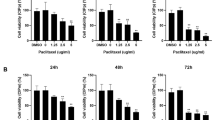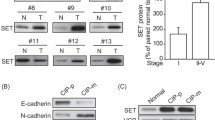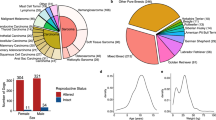Abstract
Canine mammary tumors (CMTs) are the most common neoplasms in intact female dogs. Some clinical and molecular similarities between certain CMT subtypes and breast cancer make them a potential model for the study of the human disease. As misregulated Hippo signaling is thought to play an important role in breast cancer development and also occurs in CMTs, we sought to determine if Hippo represents a valid pharmacological target for the treatment of CMTs. Six CMT cell lines were assessed for their expression of the Hippo pathway effectors YAP and TAZ and for their sensitivity to verteporfin, an inhibitor of YAP-mediated transcriptional coactivation. Four cell lines that expressed YAP (CMT-9, −12, −28, −47) were found to be very sensitive to verteporfin treatment, which killed the cells through induction of apoptosis with ED50 values of 14–79 nM. Conversely, two YAP-negative cell lines (CF-35, CMT-25) were an order of magnitude more resistant to verteporfin. Verteporfin suppressed the expression of YAP/TAZ target genes, particularly CYR61 and CTGF, which play important roles in breast cancer development. Verteporfin was also able to inhibit cell migration and anchorage-independent growth. Likewise, verteporfin efficiently suppressed tumor cell invasiveness in the CMT-28 and -47 lines, but not in CF-35 cells. Together, our findings provide proof of principle that pharmacological targeting of the Hippo pathway compromises the viability and attenuates the malignant behavior of CMT cells. These results will serve as the basis for the development of novel chemotherapeutic approaches for CMTs that could translate to human medicine.







Similar content being viewed by others
References
Sleeckx N, de Rooster H, Veldhuis Kroeze EJ, et al. Canine mammary tumours, an overview. Reprod Domest Anim. 2011;46(6):1112–31.
Benjamin SA, Lee AC, Saunders WJ. Classification and behavior of canine mammary epithelial neoplasms based on life-span observations in beagles. Vet Pathol. 1999;36(5):423–36.
Sorenmo KU, Kristiansen VM, Cofone MA, et al. Canine mammary gland tumours; a histological continuum from benign to malignant; clinical and histopathological evidence. Vet Comp Oncol. 2009;7(3):162–72.
Withrow SJ, Vail DM. Withrow & MacEwen's small animal clinical oncology. 4th ed. St. Louis, Mo.: Saunders Elsevier; 2007. 1 texte électronique (xvii, 846 ) p.
Meuten DJ, Moulton JE. Tumors in domestic animals. Fifth edition. ed. Ames, Iowa: Wiley Blackwell; 2017. viii, 989 pages p.
Karayannopoulou M, Lafioniatis, S. Progrès récents chimiothérapie des tumeurs mammaires canines: examen des études de 2000 à ce jour. Revue de Médecine Vétérinaire. 2016;7–8(167):191–200.
Simon D, Schoenrock D, Baumgartner W, et al. Postoperative adjuvant treatment of invasive malignant mammary gland tumors in dogs with doxorubicin and docetaxel. J Vet Intern Med. 2006;20(5):1184–90.
Klopfleisch R, von Euler H, Sarli G, et al. Molecular carcinogenesis of canine mammary tumors: news from an old disease. Vet Pathol. 2011;48(1):98–116.
Marconato L, Lorenzo RM, Abramo F, et al. Adjuvant gemcitabine after surgical removal of aggressive malignant mammary tumours in dogs. Vet Comp Oncol. 2008;6(2):90–101.
Harvey KF, Zhang X, Thomas DM. The hippo pathway and human cancer. Nat Rev Cancer. 2013;13(4):246–57.
Johnson R, Halder G. The two faces of hippo: targeting the hippo pathway for regenerative medicine and cancer treatment. Nat Rev Drug Discov. 2014;13(1):63–79.
Park HW, Guan KL. Regulation of the hippo pathway and implications for anticancer drug development. Trends Pharmacol Sci. 2013;34(10):581–9.
Zhao B, Wei X, Li W, et al. Inactivation of YAP oncoprotein by the hippo pathway is involved in cell contact inhibition and tissue growth control. Genes Dev. 2007;21(21):2747–61.
Zhao B, Li L, Wang L, et al. Cell detachment activates the hippo pathway via cytoskeleton reorganization to induce anoikis. Genes Dev. 2012;26(1):54–68.
Halder G, Dupont S, Piccolo S. Transduction of mechanical and cytoskeletal cues by YAP and TAZ. Nat Rev Mol Cell Biol. 2012;13(9):591–600.
Low BC, Pan CQ, Shivashankar GV, et al. YAP/TAZ as mechanosensors and mechanotransducers in regulating organ size and tumor growth. FEBS Lett. 2014;588(16):2663–70.
Wada K, Itoga K, Okano T, et al. Hippo pathway regulation by cell morphology and stress fibers. Development. 2011;138(18):3907–14.
Zhao B, Ye X, Yu J, et al. TEAD mediates YAP-dependent gene induction and growth control. Genes Dev. 2008;22(14):1962–71.
Gomez M, Gomez V, Hergovich A. The hippo pathway in disease and therapy: cancer and beyond. Clin Transl Med. 2014;3:22.
Piccolo S, Dupont S, Cordenonsi M. The biology of YAP/TAZ: hippo signaling and beyond. Physiol Rev. 2014;94(4):1287–312.
Morin-Kensicki EM, Boone BN, Howell M, et al. Defects in yolk sac vasculogenesis, chorioallantoic fusion, and embryonic axis elongation in mice with targeted disruption of Yap65. Mol Cell Biol. 2006;26(1):77–87.
Hossain Z, Ali SM, Ko HL, et al. Glomerulocystic kidney disease in mice with a targeted inactivation of Wwtr1. Proc Natl Acad Sci U S A. 2007;104(5):1631–6.
Makita R, Uchijima Y, Nishiyama K, et al. Multiple renal cysts, urinary concentration defects, and pulmonary emphysematous changes in mice lacking TAZ. Am J Physiol Ren Physiol. 2008;294(3):F542–53.
Vlug EJ, van de Ven RA, Vermeulen JF, et al. Nuclear localization of the transcriptional coactivator YAP is associated with invasive lobular breast cancer. Cell Oncol (Dordr). 2013;36(5):375–84.
Chen Q, Zhang N, Gray RS, et al. A temporal requirement for hippo signaling in mammary gland differentiation, growth, and tumorigenesis. Genes Dev. 2014;28(5):432–7.
Barron DA, Kagey JD. The role of the hippo pathway in human disease and tumorigenesis. Clin Transl Med. 2014;3:25.
Steinhardt AA, Gayyed MF, Klein AP, et al. Expression of yes-associated protein in common solid tumors. Hum Pathol. 2008;39(11):1582–9.
Bartucci M, Dattilo R, Moriconi C, et al. TAZ is required for metastatic activity and chemoresistance of breast cancer stem cells. Oncogene. 2015;34(6):681–90.
Cordenonsi M, Zanconato F, Azzolin L, et al. The hippo transducer TAZ confers cancer stem cell-related traits on breast cancer cells. Cell. 2011;147(4):759–72.
Lamar JM, Stern P, Liu H, et al. The hippo pathway target, YAP, promotes metastasis through its TEAD-interaction domain. Proc Natl Acad Sci U S A. 2012;109(37):E2441–50.
Shi P, Feng J, Chen C. Hippo pathway in mammary gland development and breast cancer. Acta Biochim Biophys Sin Shanghai. 2015;47(1):53–9.
Chan SW, Lim CJ, Guo K, et al. A role for TAZ in migration, invasion, and tumorigenesis of breast cancer cells. Cancer Res. 2008;68(8):2592–8.
Beffagna G, Sacchetto R, Cavicchioli L, et al. A preliminary investigation of the role of the transcription co-activators YAP/TAZ of the hippo signalling pathway in canine and feline mammary tumours. Vet J. 2016;207:105–11.
Bressler NM. Verteporfin therapy of subfoveal choroidal neovascularization in age-related macular degeneration: two-year results of a randomized clinical trial including lesions with occult with no classic choroidal neovascularization-verteporfin in photodynamic therapy report 2. Am J Ophthalmol. 2002;133(1):168–9.
Blinder KJ, Blumenkranz MS, Bressler NM, et al. Verteporfin therapy of subfoveal choroidal neovascularization in pathologic myopia: 2-year results of a randomized clinical trial--VIP report no. 3. Ophthalmology. 2003;110(4):667–73.
Wang C, Zhu X, Feng W, et al. Verteporfin inhibits YAP function through up-regulating 14-3-3sigma sequestering YAP in the cytoplasm. Am J Cancer Res. 2016;6(1):27–37.
Wei H, Wang F, Wang Y, et al. Verteporfin suppresses cell survival, angiogenesis and vasculogenic mimicry of PDAC via disrupting the YAP-TEAD complex. Cancer Sci 2016.
Feng J, Gou J, Jia J, et al. Verteporfin, a suppressor of YAP-TEAD complex, presents promising antitumor properties on ovarian cancer. Onco Targets Ther. 2016;9:5371–81.
Felley-Bosco E, Stahel R. Hippo/YAP pathway for targeted therapy. Transl Lung Cancer Res. 2014;3(2):75–83.
Ma YW, Liu YZ, Pan JX. Verteporfin induces apoptosis and eliminates cancer stem-like cells in uveal melanoma in the absence of light activation. Am J Cancer Res. 2016;6(12):2816–30.
Zhang H, Ramakrishnan SK, Triner D, et al. Tumor-selective proteotoxicity of verteporfin inhibits colon cancer progression independently of YAP1. Sci Signal. 2015;8(397):ra98.
Li H, Huang Z, Gao M, et al. Inhibition of YAP suppresses CML cell proliferation and enhances efficacy of imatinib in vitro and in vivo. J Exp Clin Cancer Res. 2016;35(1):134.
Donohue E, Thomas A, Maurer N, et al. The autophagy inhibitor verteporfin moderately enhances the antitumor activity of gemcitabine in a pancreatic ductal adenocarcinoma model. J Cancer. 2013;4(7):585–96.
Lutful Kabir FM, Agarwal P, Deinnocentes P, et al. Novel frameshift mutation in the p16/INK4A tumor suppressor gene in canine breast cancer alters expression from the p16/INK4A/p14ARF locus. J Cell Biochem. 2013;114(1):56–66.
DeInnocentes P, Li LX, Sanchez RL, et al. Expression and sequence of canine SIRT2 and p53 genes in canine mammary tumour cells - effects on downstream targets Wip1 and p21/Cip1. Vet Comp Oncol. 2006;4(3):161–77.
Stokol T, Daddona JL, Mubayed LS, et al. Evaluation of tissue factor expression in canine tumor cells. Am J Vet Res. 2011;72(8):1097–106.
Abedini A, Zamberlam G, Lapointe E, et al. WNT5a is required for normal ovarian follicle development and antagonizes gonadotropin responsiveness in granulosa cells by suppressing canonical WNT signaling. FASEB J. 2016;30(4):1534–47.
Livak KJ, Schmittgen TD. Analysis of relative gene expression data using real-time quantitative PCR and the 2(−Delta Delta C(T)) method. Methods. 2001;25(4):402–8.
Santucci M, Vignudelli T, Ferrari S, et al. The hippo pathway and YAP/TAZ-TEAD protein-protein interaction as targets for regenerative medicine and cancer treatment. J Med Chem. 2015;58(12):4857–73.
Fu D, Lv X, Hua G, et al. YAP regulates cell proliferation, migration, and steroidogenesis in adult granulosa cell tumors. Endocr Relat Cancer. 2014;21(2):297–310.
Aqeilan RI. Hippo signaling: to die or not to die. Cell Death Differ. 2013;20(10):1287–8.
Maugeri-Sacca M, De Maria R. Hippo pathway and breast cancer stem cells. Crit Rev Oncol Hematol. 2016;99:115–22.
Kleer CG. Dual roles of CCN proteins in breast cancer progression. J Cell Commun Signal. 2016;10(3):217–22.
Tsai MS, Bogart DF, Castaneda JM, et al. Cyr61 promotes breast tumorigenesis and cancer progression. Oncogene. 2002;21(53):8178–85.
Jiang WG, Watkins G, Fodstad O, et al. Differential expression of the CCN family members Cyr61, CTGF and Nov in human breast cancer. Endocr Relat Cancer. 2004;11(4):781–91.
Sanchez-Bailon MP, Calcabrini A, Mayoral-Varo V, et al. Cyr61 as mediator of Src signaling in triple negative breast cancer cells. Oncotarget. 2015;6(15):13520–38.
Espinoza I, Menendez JA, Kvp CM, et al. CCN1 promotes vascular endothelial growth factor secretion through alphavbeta 3 integrin receptors in breast cancer. J Cell Commun Signal. 2014;8(1):23–7.
Harris LG, Pannell LK, Singh S, et al. Increased vascularity and spontaneous metastasis of breast cancer by hedgehog signaling mediated upregulation of cyr61. Oncogene. 2012;31(28):3370–80.
Xie D, Nakachi K, Wang H, et al. Elevated levels of connective tissue growth factor, WISP-1, and CYR61 in primary breast cancers associated with more advanced features. Cancer Res. 2001;61(24):8917–23.
Wang MY, Chen PS, Prakash E, et al. Connective tissue growth factor confers drug resistance in breast cancer through concomitant up-regulation of Bcl-xL and cIAP1. Cancer Res. 2009;69(8):3482–91.
Chien W, O'Kelly J, Lu D, et al. Expression of connective tissue growth factor (CTGF/CCN2) in breast cancer cells is associated with increased migration and angiogenesis. Int J Oncol. 2011;38(6):1741–7.
Lai D, Ho KC, Hao Y, et al. Taxol resistance in breast cancer cells is mediated by the hippo pathway component TAZ and its downstream transcriptional targets Cyr61 and CTGF. Cancer Res. 2011;71(7):2728–38.
Morishita T, Hayakawa F, Sugimoto K, et al. The photosensitizer verteporfin has light-independent anti-leukemic activity for Ph-positive acute lymphoblastic leukemia and synergistically works with dasatinib. Oncotarget. 2016;7(35):56241–52.
Ciamporcero E, Shen H, Ramakrishnan S, et al. YAP activation protects urothelial cell carcinoma from treatment-induced DNA damage. Oncogene. 2016;35(12):1541–53.
Hussain RN, Jmor F, Damato B, et al. Verteporfin photodynamic therapy for the treatment of choroidal haemangioma associated with Sturge-weber syndrome. Photodiagn Photodyn Ther. 2016;15:143–6.
Gupta R, Browning AC, Wu K, et al. Verteporfin photodynamic therapy for the treatment of persistent subfoveal choroidal neovascularization after external beam radiotherapy: one-year results. Am J Ophthalmol. 2005;139(3):561–2.
Mori R, Kelkar A, De Laey JJ. Photodynamic therapy with verteporfin in Belgian patients with subfoveal choroidal neovascularization secondary to age-related macular degeneration. Bull Soc Belge Ophtalmol. 2006;299:57–64.
Tayanithi P, Pisankosakul P, Laksakapuk P. Treatment of subfoveal choroidal neovascularization secondary to age related macular degeneration with single treatment of verteporfin photodynamic therapy: a safety and short-term outcome. J Med Assoc Thail. 2004;87(Suppl 2):S78–82.
Josefsen LB, Boyle RW. Photodynamic therapy and the development of metal-based photosensitisers. Metal-Based Drugs. 2008;2008:276109.
Likus W, Siemianowicz K, Bienk K, et al. Could drugs inhibiting the mevalonate pathway also target cancer stem cells? Drug Resist Updat. 2016;25:13–25.
Wang Z, Wu Y, Wang H, et al. Interplay of mevalonate and hippo pathways regulates RHAMM transcription via YAP to modulate breast cancer cell motility. Proc Natl Acad Sci U S A 2014;111(1):E89–E98.
Lin Q, Yang W. The hippo-YAP/TAZ pathway mediates geranylgeranylation signaling in breast cancer progression. Mol Cell Oncol. 2016;3(3):e969638.
Sorrentino G, Ruggeri N, Specchia V, et al. Metabolic control of YAP and TAZ by the mevalonate pathway. Nat Cell Biol. 2014;16(4):357–66.
Undela K, Srikanth V, Bansal D. Statin use and risk of breast cancer: a meta-analysis of observational studies. Breast Cancer Res Treat. 2012;135(1):261–9.
Acknowledgements
The authors thank Ms. Meggie Girard for excellent technical assistance and Mr. Guy Beauchamp for statistical analyses.
Author information
Authors and Affiliations
Corresponding author
Ethics declarations
Funding
This work was supported by a First Award grant from the Morris Animal Foundation to MP. SG was supported by a bursary from the Fonds de Recherche du Québec – Nature et Technologies.
Conflict of Interest
The authors declare that they have no conflict of interest.
Rights and permissions
About this article
Cite this article
Guillemette, S., Rico, C., Godin, P. et al. In Vitro Validation of the Hippo Pathway as a Pharmacological Target for Canine Mammary Gland Tumors. J Mammary Gland Biol Neoplasia 22, 203–214 (2017). https://doi.org/10.1007/s10911-017-9384-9
Received:
Accepted:
Published:
Issue Date:
DOI: https://doi.org/10.1007/s10911-017-9384-9




